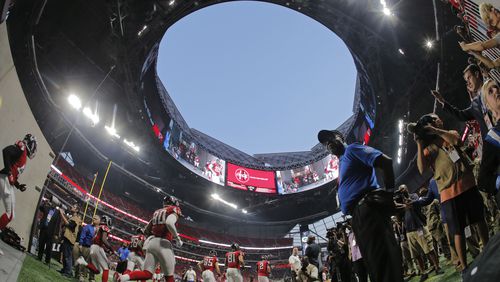Before the Super Bowl is played at Mercedes-Benz Stadium early next year, stadium officials aim to have the retractable roof in operating order, the sound system functioning better and a new green space open on the former Georgia Dome site.
There’s a lot of work to be done in the meantime.
The $1.5 billion-plus stadium opened almost six months ago after more than three years of construction, but parts of the project remain works in progress, most noticeably the automation of the roof and the transformation of the Dome site to a grass tailgating and gathering space.
“We’re also meeting every week on all kinds of little things we’re still finishing in the building,” Scott Jenkins, the stadium’s general manager, said last week. “It takes two years (after opening), in my experience, to finish a building and get it running the way you want.”
This time of year is the relative lull on the multi-purpose stadium’s schedule, with only two major events – the Monster Jam trucks tour Feb. 24-25 and Supercross motorcycle racing March 3 – before the first home match of Atlanta United’s second season March 11. So it’s a convenient time to focus on the needs of the venue, away from the demands of football season.
Within the next couple of weeks, before Monster Jam, three additional sets of double doors and one overhead rolling door will be installed on the east end of the stadium as part of efforts to address the considerable congestion as fans exit the building after events.
At the top of the stadium, work has re-intensified on the problematic retractable roof, which has been open for only two events. Both Jenkins and Falcons owner Arthur Blank said recently that they expect the roof to be fully operational by summer, although past roof timetables have proved overly optimistic.
Next door to the stadium, about 131,000 tons of concrete from the imploded Georgia Dome have been crushed, leaving another 39,000 tons to be dealt with. The crushed concrete will be spread across the site, raising the ground to form the base for the "Home Depot Backyard," a 13-acre green space that will be used for parking, tailgating and pregame activities at stadium events and as a community park at other times.
The Falcons said work is on track for the "Backyard" to be substantially complete by September for the start of the team's second season in the stadium. Longer-term plans also call for a 1,010-room high-rise hotel on about one acre of the Dome site, but construction on that isn't expected to begin until after the Super Bowl.
Reviews have been mixed of late on how the stadium performed in its inaugural season.
The Falcons announced the results of an NFL-conducted fan survey in which the stadium scored impressively, ranking No. 3 in the league for overall game-day satisfaction and No. 1 for food and beverage. But Georgia World Congress Center Authority board members raised stern concerns about several aspects of the stadium's operation in a recent meeting.
The GWCCA board, which has an oversight role over the state-owned, Falcons-operated stadium, questioned the long delays to enter the stadium for college football’s national championship game Jan. 8, as well as ongoing problems with exiting the stadium and with the sound system.
Stadium and College Football Playoff officials attributed the entrance problems at the national title game to security decisions, including a lengthy gate closing, made by the U.S. Secret Service because of President Donald Trump’s attendance. But stadium officials acknowledged the need for improvements in other areas, including egress and the sound system.
The Falcons have proposed $3.4 million in capital expenditures at the stadium this year. The expenditures, subject to GWCCA review, will be paid from Atlanta hotel-motel tax revenue under terms of the stadium deal.
The additional doors, costing $185,000, are the first item on a lengthy list. (Other items range from adding a roof structure above a trash compactor to adding a guard shack at the loading dock to “bird-control management.”) The new doors will lead to the stadium’s “front porch,” an outdoor fan plaza.
"Our toughest issue is exit, when everybody leaves at the same time," Steve Cannon, CEO of Falcons and Atlanta United parent company AMB Group, said recently. In addition to the new doors, Cannon said, "there will be some other tweaks" to improve exit flow.
The stadium has four main gates, with three of them located in roughly the northwest, northeast and southeast corners and the other on the east end. Stadium officials hope the opening of Home Depot Backyard and a new parking deck in that area will cause more fans to use the northwest gate, called Gate 1, and a north suite/club entry to spread out the flow within the building.
But some GWCCA board members expressed concern about whether the proposed capital expenditures adequately address the issues with egress and the stadium audio, which has been garbled in some locations.
“That sound system needs to be fixed – and fixed soon,” board member Phil Gingrey said.
Stadium officials said a number of steps have been taken, including adjusting speaker angles, controlling volume by zones, reviewing the stadium setup for concerts and testing other possible changes.
“It’s a complicated issue,” Jenkins said. “We’re going to continue working on it.”
The stadium’s next big audio test will be a Kenny Chesney concert May 26.
Meanwhile, there apparently has been some progress with the much-discussed retractable roof, which largely has remained closed and has occasionally leaked. The roof's automation wasn't completed before the stadium opened, and officials said there wasn't sufficient time to work on it between events during football season. But the roof was opened with the push of a button for the first time in mid-January, according to Jenkins.
“We just did our first operational move, open and close … automated,” he said recently. “It’s still slow because we’re still in the training-wheel phase, but that’s progress because before that it was all manual construction moves.
“They’re still working on it every day, every night. … It’s encouraging.”
It’s probably unlikely that the Super Bowl would be played with the roof open in any case, given typical Atlanta weather for early February nights. But the Falcons want the NFL to have that option Feb. 3, 2019.
About the Author







